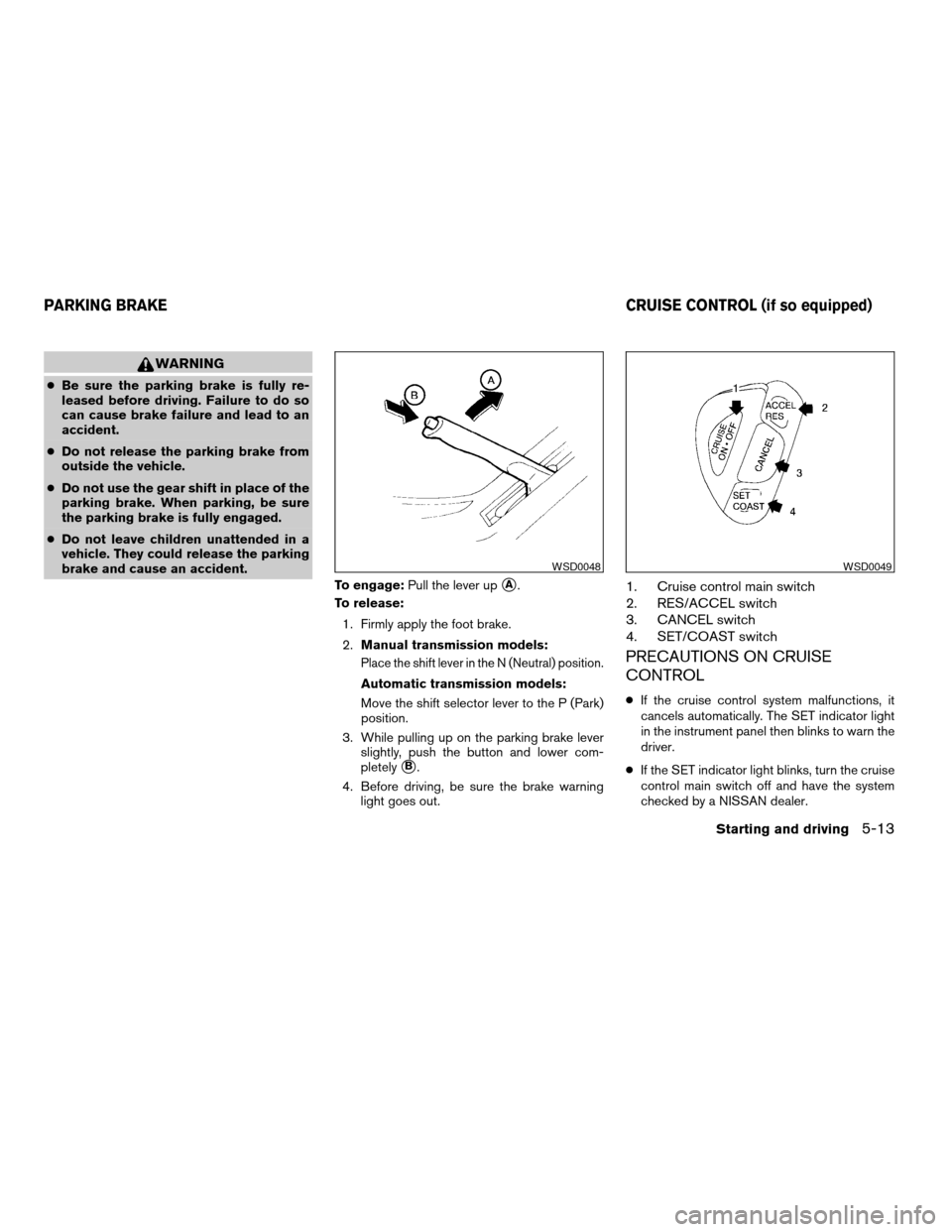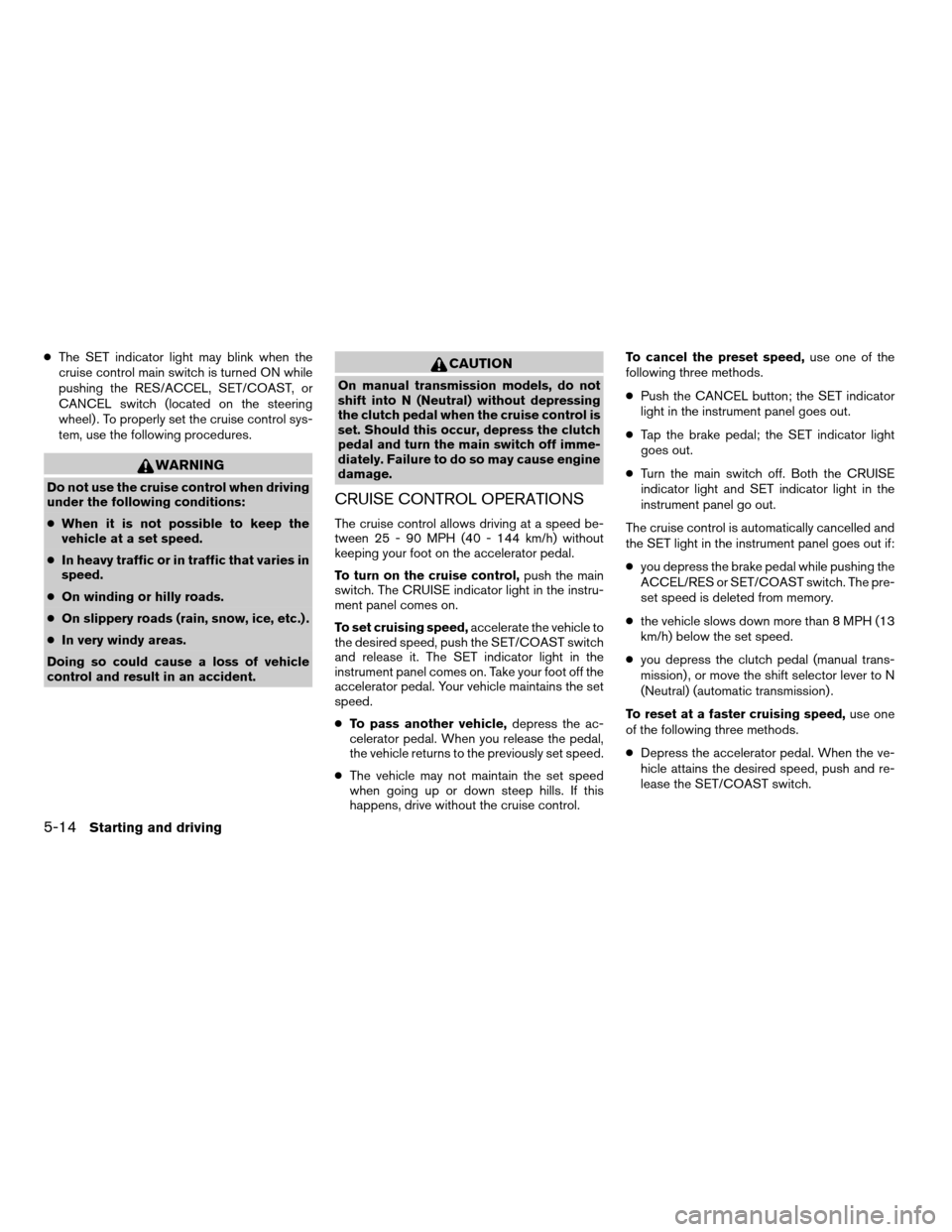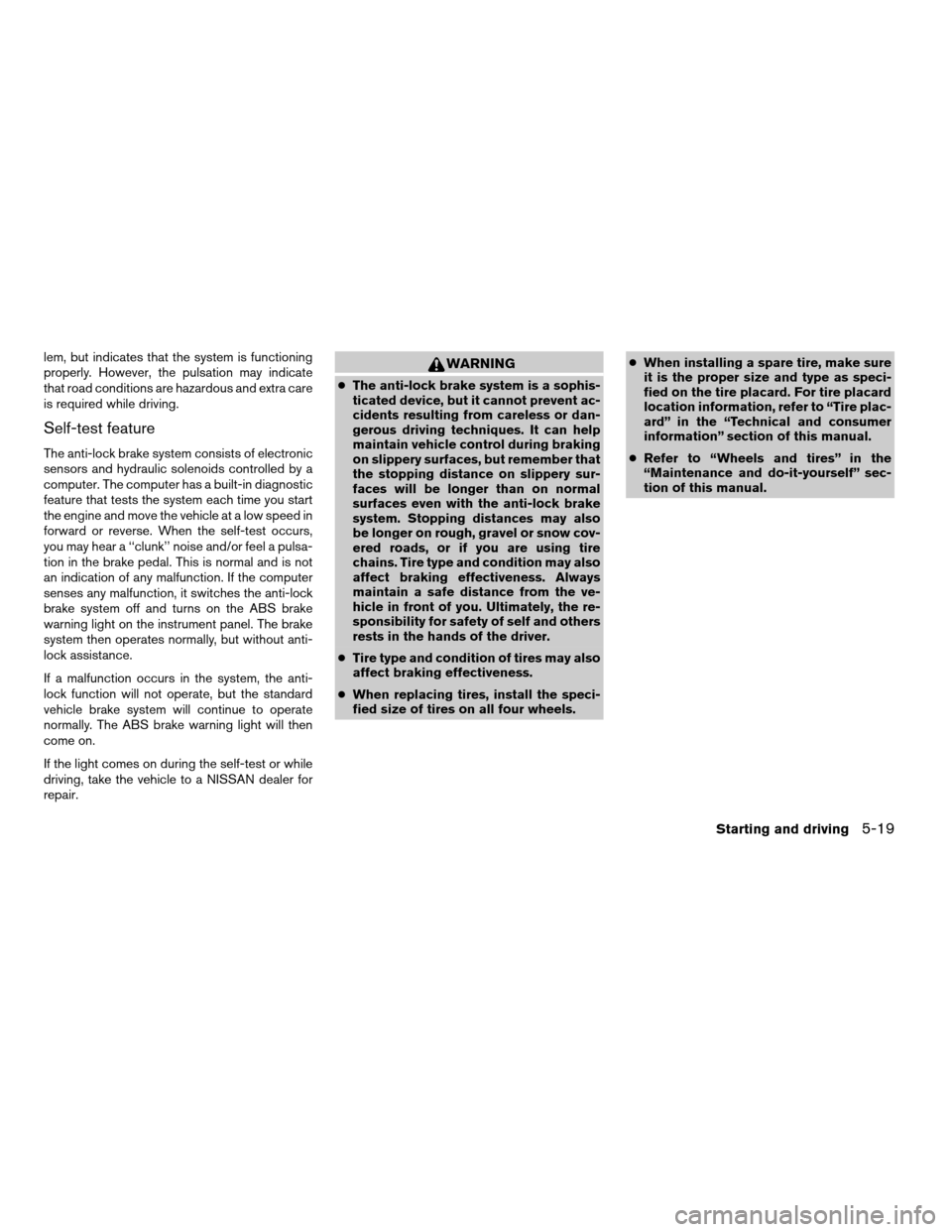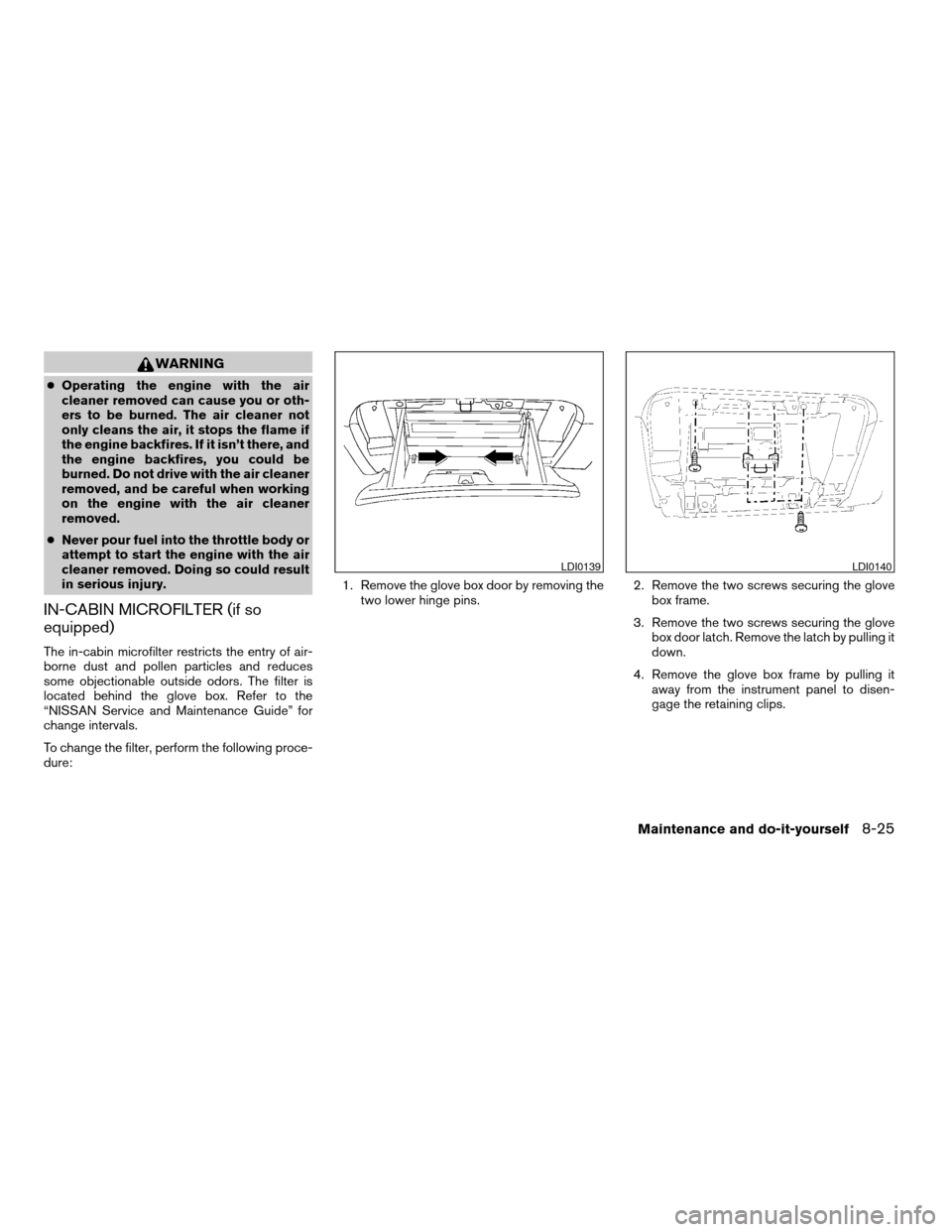2003 NISSAN SENTRA instrument panel
[x] Cancel search: instrument panelPage 121 of 224

WARNING
cBe sure the parking brake is fully re-
leased before driving. Failure to do so
can cause brake failure and lead to an
accident.
cDo not release the parking brake from
outside the vehicle.
cDo not use the gear shift in place of the
parking brake. When parking, be sure
the parking brake is fully engaged.
cDo not leave children unattended in a
vehicle. They could release the parking
brake and cause an accident.
To engage:Pull the lever up
sA.
To release:
1. Firmly apply the foot brake.
2.Manual transmission models:
Place the shift lever in the N (Neutral) position.
Automatic transmission models:
Move the shift selector lever to the P (Park)
position.
3. While pulling up on the parking brake lever
slightly, push the button and lower com-
pletely
sB.
4. Before driving, be sure the brake warning
light goes out.
1. Cruise control main switch
2. RES/ACCEL switch
3. CANCEL switch
4. SET/COAST switch
PRECAUTIONS ON CRUISE
CONTROL
cIf the cruise control system malfunctions, it
cancels automatically. The SET indicator light
in the instrument panel then blinks to warn the
driver.
cIf the SET indicator light blinks, turn the cruise
control main switch off and have the system
checked by a NISSAN dealer.
WSD0048WSD0049
PARKING BRAKE CRUISE CONTROL (if so equipped)
Starting and driving5-13
ZREVIEW COPY:Ð2003 Sentra(b15)
Owners Manual(owners)ÐUSA English(nna)
12/20/02Ðcathy
X
Page 122 of 224

cThe SET indicator light may blink when the
cruise control main switch is turned ON while
pushing the RES/ACCEL, SET/COAST, or
CANCEL switch (located on the steering
wheel) . To properly set the cruise control sys-
tem, use the following procedures.
WARNING
Do not use the cruise control when driving
under the following conditions:
cWhen it is not possible to keep the
vehicle at a set speed.
cIn heavy traffic or in traffic that varies in
speed.
cOn winding or hilly roads.
cOn slippery roads (rain, snow, ice, etc.) .
cIn very windy areas.
Doing so could cause a loss of vehicle
control and result in an accident.
CAUTION
On manual transmission models, do not
shift into N (Neutral) without depressing
the clutch pedal when the cruise control is
set. Should this occur, depress the clutch
pedal and turn the main switch off imme-
diately. Failure to do so may cause engine
damage.
CRUISE CONTROL OPERATIONS
The cruise control allows driving at a speed be-
tween 25 - 90 MPH (40 - 144 km/h) without
keeping your foot on the accelerator pedal.
To turn on the cruise control,push the main
switch. The CRUISE indicator light in the instru-
ment panel comes on.
To set cruising speed,accelerate the vehicle to
the desired speed, push the SET/COAST switch
and release it. The SET indicator light in the
instrument panel comes on. Take your foot off the
accelerator pedal. Your vehicle maintains the set
speed.
cTo pass another vehicle,depress the ac-
celerator pedal. When you release the pedal,
the vehicle returns to the previously set speed.
cThe vehicle may not maintain the set speed
when going up or down steep hills. If this
happens, drive without the cruise control.To cancel the preset speed,use one of the
following three methods.
cPush the CANCEL button; the SET indicator
light in the instrument panel goes out.
cTap the brake pedal; the SET indicator light
goes out.
cTurn the main switch off. Both the CRUISE
indicator light and SET indicator light in the
instrument panel go out.
The cruise control is automatically cancelled and
the SET light in the instrument panel goes out if:
cyou depress the brake pedal while pushing the
ACCEL/RES or SET/COAST switch. The pre-
set speed is deleted from memory.
cthe vehicle slows down more than 8 MPH (13
km/h) below the set speed.
cyou depress the clutch pedal (manual trans-
mission) , or move the shift selector lever to N
(Neutral) (automatic transmission) .
To reset at a faster cruising speed,use one
of the following three methods.
cDepress the accelerator pedal. When the ve-
hicle attains the desired speed, push and re-
lease the SET/COAST switch.
5-14Starting and driving
ZREVIEW COPY:Ð2003 Sentra(b15)
Owners Manual(owners)ÐUSA English(nna)
12/20/02Ðcathy
X
Page 127 of 224

lem, but indicates that the system is functioning
properly. However, the pulsation may indicate
that road conditions are hazardous and extra care
is required while driving.
Self-test feature
The anti-lock brake system consists of electronic
sensors and hydraulic solenoids controlled by a
computer. The computer has a built-in diagnostic
feature that tests the system each time you start
the engine and move the vehicle at a low speed in
forward or reverse. When the self-test occurs,
you may hear a ‘‘clunk’’ noise and/or feel a pulsa-
tion in the brake pedal. This is normal and is not
an indication of any malfunction. If the computer
senses any malfunction, it switches the anti-lock
brake system off and turns on the ABS brake
warning light on the instrument panel. The brake
system then operates normally, but without anti-
lock assistance.
If a malfunction occurs in the system, the anti-
lock function will not operate, but the standard
vehicle brake system will continue to operate
normally. The ABS brake warning light will then
come on.
If the light comes on during the self-test or while
driving, take the vehicle to a NISSAN dealer for
repair.
WARNING
cThe anti-lock brake system is a sophis-
ticated device, but it cannot prevent ac-
cidents resulting from careless or dan-
gerous driving techniques. It can help
maintain vehicle control during braking
on slippery surfaces, but remember that
the stopping distance on slippery sur-
faces will be longer than on normal
surfaces even with the anti-lock brake
system. Stopping distances may also
be longer on rough, gravel or snow cov-
ered roads, or if you are using tire
chains. Tire type and condition may also
affect braking effectiveness. Always
maintain a safe distance from the ve-
hicle in front of you. Ultimately, the re-
sponsibility for safety of self and others
rests in the hands of the driver.
cTire type and condition of tires may also
affect braking effectiveness.
cWhen replacing tires, install the speci-
fied size of tires on all four wheels.cWhen installing a spare tire, make sure
it is the proper size and type as speci-
fied on the tire placard. For tire placard
location information, refer to “Tire plac-
ard” in the “Technical and consumer
information” section of this manual.
cRefer to “Wheels and tires” in the
“Maintenance and do-it-yourself” sec-
tion of this manual.
Starting and driving5-19
ZREVIEW COPY:Ð2003 Sentra(b15)
Owners Manual(owners)ÐUSA English(nna)
12/20/02Ðcathy
X
Page 173 of 224

WARNING
cOperating the engine with the air
cleaner removed can cause you or oth-
ers to be burned. The air cleaner not
only cleans the air, it stops the flame if
the engine backfires. If it isn’t there, and
the engine backfires, you could be
burned. Do not drive with the air cleaner
removed, and be careful when working
on the engine with the air cleaner
removed.
cNever pour fuel into the throttle body or
attempt to start the engine with the air
cleaner removed. Doing so could result
in serious injury.
IN-CABIN MICROFILTER (if so
equipped)
The in-cabin microfilter restricts the entry of air-
borne dust and pollen particles and reduces
some objectionable outside odors. The filter is
located behind the glove box. Refer to the
“NISSAN Service and Maintenance Guide” for
change intervals.
To change the filter, perform the following proce-
dure:1. Remove the glove box door by removing the
two lower hinge pins.2. Remove the two screws securing the glove
box frame.
3. Remove the two screws securing the glove
box door latch. Remove the latch by pulling it
down.
4. Remove the glove box frame by pulling it
away from the instrument panel to disen-
gage the retaining clips.
LDI0139LDI0140
Maintenance and do-it-yourself8-25
ZREVIEW COPY:Ð2003 Sentra(b15)
Owners Manual(owners)ÐUSA English(nna)
12/20/02Ðcathy
X
Page 215 of 224

10 Index
A
Air bag (See supplemental restraint
system)......................1-6
Air bag warning light...........1-17, 2-9
Air cleaner housing filter............8-24
Air conditioner
Air conditioner operation...........4-5
Air conditioner service............4-9
Air conditioner specification label.....9-11
Air conditioner system refrigerant and
lubrication recommendations........9-6
Heater and air conditioner controls.....4-2
Servicing air conditioner...........4-9
Air flow charts..................4-6
Alarm system
(See vehicle security system).........2-11
Anchor point locations.............1-35
Antenna.....................4-19
Anti-lock brake system (ABS).........5-18
Anti-lock brake warning light..........2-7
Audible reminders................2-10
Audio system..................4-10
Compact Disc (CD) changer.......4-17
Compact disc (CD) player.........4-15
FM-AM radio with compact disc (CD)
player....................4-12
Radio....................4-10
Automatic
Automatic power window switch.....2-25
Automatic transmission fluid (ATF). . . .8-15Driving with automatic transmission.....5-7
Transmission selector lever lock release . .5-9
B
Battery......................8-20
Charge warning light.............2-8
Battery replacement
(See remote keyless entry system).......3-8
Before starting the engine............5-6
Belts (See drive belts).............8-22
Brake
Anti-lock brake system (ABS).......5-18
Brake booster................8-30
Brake fluid..................8-18
Brake light (See stop light).........8-36
Brake pedal.................8-29
Brake system................5-18
Brake warning light..............2-7
Brake wear indicators........2-10, 8-30
Parking brake check............8-29
Parking brake operation..........5-13
Self-adjusting brakes............8-30
Break-in schedule................5-15
Bulb check/instrument panel..........2-7
Bulb replacement................8-36
C
Capacities and recommended fuel/lubricants. .9-2Car phone or CB radio.............4-19
Cargo (See vehicle loading information) . . .9-12
CD changer (See audio system)........4-17
CD player (See audio system).........4-15
Check engine indicator light
(See malfunction indicator light).........2-9
Child restraint with top tether strap......1-34
Child restraints.......1-20, 1-21, 1-25, 1-33
Precautions on child restraints.......1-25
Child safety rear door lock............3-5
Chimes, audible reminders...........2-10
Cleaning exterior and interior..........7-2
Clock......................4-13
Clutch
Clutch fluid.................8-19
Coin box.....................2-22
Cold weather driving..............5-20
Compact disc (CD) player...........4-15
Console box...................2-23
Controls
Heater and air conditioner controls.....4-2
Coolant
Capacities and recommended
fuel/lubricants.................9-2
Changing engine coolant..........8-10
Checking engine coolant level........8-9
Engine coolant temperature gauge.....2-5
Corrosion protection...............7-5
Cruise control..................5-13
Cup holders...................2-21
ZREVIEW COPY:Ð2003 Sentra(b15)
Owners Manual(owners)ÐUSA English(nna)
12/20/02Ðcathy
X
Page 217 of 224

Increasing fuel economy............5-15
Indicator lights and audible reminders
(See warning/indicator lights and
audible reminders)................2-7
Inside mirror...................3-14
Instrument brightness control.........2-18
Instrument panel.................2-2
Interior light...................2-27
Interior trunk lid release.............3-11
J
Jump starting...................6-7
K
Key ........................3-2
Keyless entry system (See remote keyless
entry system)...................3-5
L
Labels
Air conditioner specification label.....9-11
Emission control information label.....9-11
Engine serial number............9-10
F.M.V.S.S. certification label........9-10
Vehicle identification number (VIN) plate . .9-9
Warning labels (for SRS)..........1-16
LATCH (Lower Anchors and Tether for Children)
System......................1-33
License plate
Installing the license plate.........9-12Light
Air bag warning light.........1-17, 2-9
Brake light (See stop light).........8-36
Bulb check/instrument panel........2-7
Bulb replacement..............8-36
Charge warning light.............2-8
Front fog light switch............2-18
Headlight aiming adjustment........8-35
Headlight and turn signal switch......2-16
Headlights..................8-34
Interior light.................2-27
Light bulbs..................8-34
Low washer fluid warning light.......2-8
Spotlights (See map light).........2-28
Trunk light..................2-28
Warning/indicator lights and audible
reminders...................2-7
Lock
Child safety rear door lock..........3-5
Door locks..................3-3
Fuel filler lid lock opener lever.......3-12
Power door locks...............3-4
Trunk lid lock opener lever..........3-9
Low fuel warning light..............2-8
Luggage (See vehicle loading information) . .9-12
M
Maintenance
General maintenance............8-2
Inside the vehicle...............8-3
Maintenance precautions..........8-5
Outside the vehicle..............8-2
Seat belt maintenance...........1-25
Under the hood and vehicle.........8-4Malfunction indicator lamp (MIL)........2-9
Manual front seat adjustment..........1-2
Manual windows................2-26
Map lights....................2-28
Meters and gauges................2-3
Mirror
Inside mirror.................3-14
Outside mirror control...........3-15
Vanity mirror.................3-14
Multi-remote control system
(See remote keyless entry system).......3-5
Multi-remote controller battery replacement .8-33
N
Nissan vehicle immobilizer system
(NVIS).................2-11, 3-2, 5-5
O
Octane rating (See fuel octane rating).....9-4
Odometer.....................2-3
Oil
Capacities and recommended
fuel/lubricants.................9-2
Changing engine oil............8-13
Changing engine oil filter..........8-14
Checking engine oil level..........8-12
Engine oil..................8-12
Engine oil and oil filter recommendation . .9-5
Engine oil viscosity..............9-5
Outside mirror control.............3-15
Overdrive switch................5-10
10-3
ZREVIEW COPY:Ð2003 Sentra(b15)
Owners Manual(owners)ÐUSA English(nna)
12/20/02Ðcathy
X